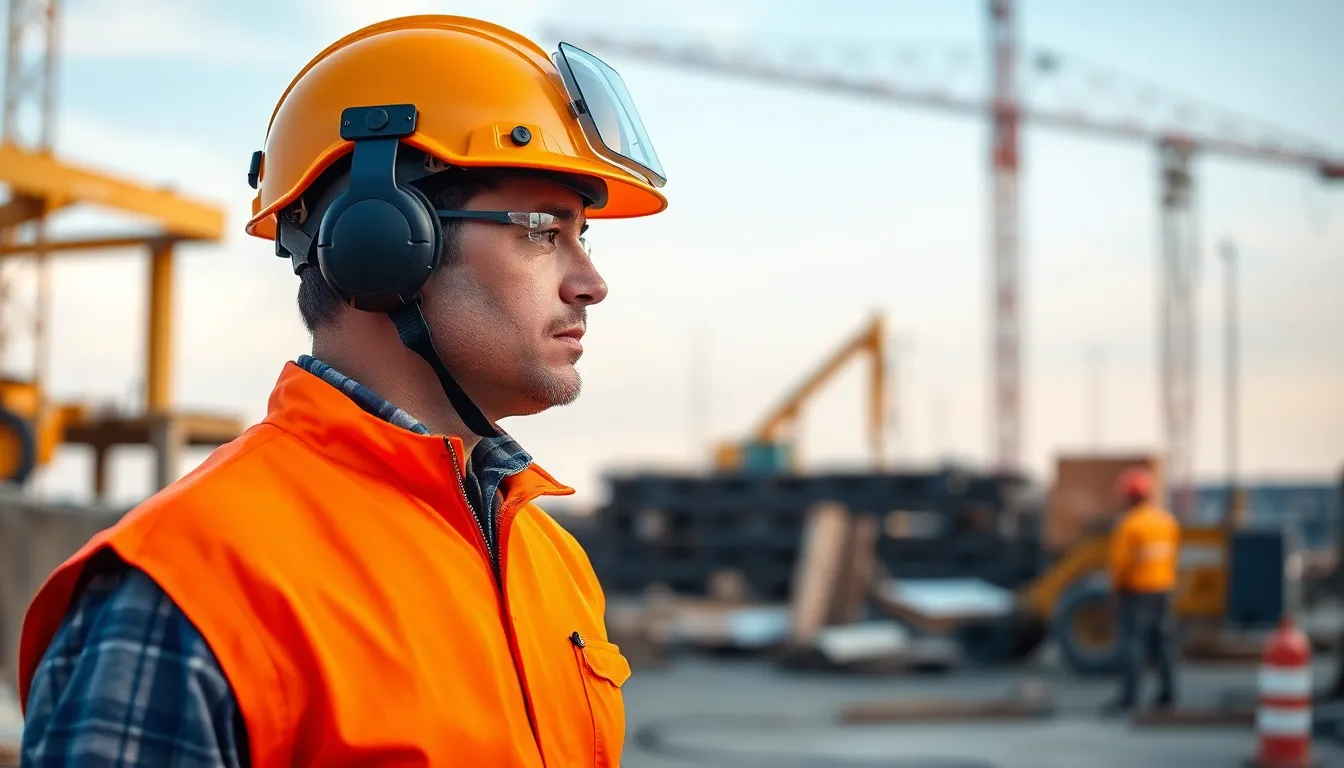In the bustling world of construction, where hard hats and steel-toed boots reign supreme, a new player is stepping onto the scene: construction wearables. Imagine a worker equipped with smart helmets and high-tech vests that not only protect but also keep them connected and informed. It’s like giving them superhero powers—minus the cape, of course.
These innovative gadgets aren’t just for show; they’re transforming job sites into safer, more efficient environments. With real-time data at their fingertips, workers can dodge hazards like a pro and boost productivity faster than you can say “hard hat area.” So, if you thought construction was all about brute strength, think again. The future’s here, and it’s got a tech-savvy twist that’s sure to make even the most seasoned builders raise an eyebrow—or two.
Table of Contents
ToggleOverview of Construction Wearables
Construction wearables encompass a range of advanced devices aimed at enhancing safety and efficiency on job sites. Smart helmets, equipped with augmented reality (AR), provide real-time information overlaying the worker’s view, reducing accidents caused by misinformation. High-tech vests monitor vital signs and environmental conditions, ensuring immediate alerts when risks arise, such as excessive heat or drops in heart rate.
Wearables like smart gloves and boots further contribute to enhanced safety measures. Smart gloves enable workers to interact with digital interfaces, while smart boots track location and movements, ensuring accountability and reducing the risk of accidents. Data collected from these devices allows managers to identify trends, streamline operations, and address potential hazards before they escalate.
The integration of construction wearables in ongoing projects helps fulfill regulatory requirements, ensuring compliance with safety standards. With functionalities such as GPS tracking, fall detection, and environmental monitoring, these devices foster a culture of safety.
According to industry reports, construction wearables can reduce workplace injuries by up to 20%, showcasing their significant impact on overall worker safety. By leveraging advanced technology, construction firms empower workers through improved connectivity and real-time data access, effectively transforming traditional work environments into high-tech job sites.
Construction wearables represent a significant advancement in how workers ensure safety and productivity. Innovations in monitoring and communication technologies are reshaping the landscape of the construction industry, highlighting the importance of investing in protective and data-driven devices.
Types of Construction Wearables

Construction wearables encompass a variety of advanced devices designed to enhance safety and productivity on job sites.
Smart Helmets
Smart helmets integrate augmented reality to provide real-time information directly to the user. These helmets feature heads-up displays that deliver critical metrics such as site maps, hazard alerts, and communication tools. Workers equipped with smart helmets benefit from enhanced situational awareness, which significantly reduces accident rates. Research shows that using these helmets can improve overall safety by streamlining information sharing and decision-making on-site.
Wearable Exoskeletons
Wearable exoskeletons support workers by reducing physical strain during manual tasks. These devices assist with lifting heavy materials, allowing workers to perform tasks with less exertion, ultimately reducing fatigue. Exoskeletons come equipped with features that promote ergonomic positioning while maintaining worker mobility. Reports indicate that implementing exoskeleton technology can lead to substantial reductions in musculoskeletal injuries, ensuring greater workforce sustainability.
Safety Vests with Sensors
Safety vests equipped with sensors monitor vital signs and environmental conditions, enhancing worker safety on the job site. These vests can alert wearers to potential dangers like high temperatures or fatigue, triggering timely interventions. The integration of GPS technology allows for real-time location tracking, ensuring that supervisors can promptly respond to emergencies. Studies confirm that enhanced monitoring capabilities from smart vests can significantly lower incident rates by facilitating rapid responses in hazardous situations.
Benefits of Construction Wearables
Construction wearables deliver numerous advantages that significantly enhance worker safety, productivity, and real-time data access. These benefits have a profound impact on the effectiveness of job site operations.
Enhanced Safety
Wearable devices improve safety through proactive hazard detection. Smart helmets equipped with augmented reality provide real-time alerts about nearby risks, allowing workers to act swiftly. Safety vests with built-in sensors monitor vital signs such as heart rate and body temperature, detecting any anomalies that may signal health issues. Wearable technology can reduce workplace injuries by up to 20% by ensuring that workers remain aware of their surroundings and receive immediate assistance when necessary.
Improved Productivity
Wearables enhance productivity by streamlining communication and task management. Devices like smart gloves facilitate interaction with digital interfaces, allowing workers to access crucial project information without interrupting their workflow. Enhanced connectivity fosters collaboration among team members, reducing delays and ensuring that tasks are completed efficiently. Wearable exoskeletons further contribute by permitting workers to perform manual tasks with less physical strain, optimizing energy and focus throughout the workday.
Real-time Data Monitoring
Real-time data monitoring through construction wearables allows for data collection that informs better decision-making. These devices gather metrics on worker performance, environmental conditions, and equipment usage, helping managers identify trends and potential hazards promptly. With access to live updates, construction teams can adjust operations to maximize safety and efficiency. This proactive approach not only mitigates risks but also supports regulatory compliance and fosters a culture of safety on job sites.
Challenges and Considerations
Construction wearables face various challenges that companies must address for successful implementation. Key considerations include cost implications and data privacy concerns.
Cost Implications
Investing in construction wearables requires careful financial planning. Initial costs can be significant due to the purchase and deployment of devices such as smart helmets and safety vests. Ongoing expenses related to software updates, maintenance, and training personnel also add to the total investment. Employers must assess the return on investment (ROI) from reduced injuries and improved productivity to justify the expenditure. Organizations may find it beneficial to explore financing options or grant programs to alleviate financial burdens while integrating these advanced technologies into their operations.
Data Privacy Concerns
Data privacy poses critical challenges in the use of construction wearables. These devices collect sensitive information, including location tracking and health metrics, raising concerns about how this data is stored and utilized. Employers must establish stringent data security protocols to protect workers’ personal information and comply with regulations such as the General Data Protection Regulation (GDPR). Transparency in data management practices can foster trust among employees while ensuring that the collection and use of data align with ethical standards. Organizations must prioritize data privacy to mitigate risks associated with breaches or unauthorized use of information.
Construction wearables are revolutionizing the industry by enhancing safety and efficiency on job sites. These innovative devices not only protect workers but also provide essential data that can prevent accidents and improve overall productivity. As technology continues to evolve, the integration of wearables will likely become a standard practice in construction, fostering a proactive culture of safety.
While challenges like costs and data privacy exist, the potential benefits far outweigh these concerns. By investing in construction wearables, companies can significantly reduce workplace injuries and create a more sustainable workforce. Embracing this technological shift will ultimately lead to safer and more productive construction environments, setting a new standard for the industry.



